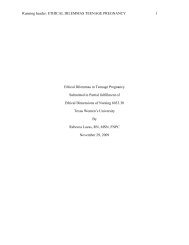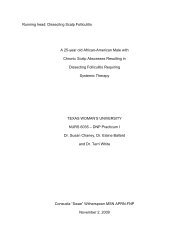Case Presentation and Plan for Scenario ... - essentiavitae.com
Case Presentation and Plan for Scenario ... - essentiavitae.com
Case Presentation and Plan for Scenario ... - essentiavitae.com
- No tags were found...
You also want an ePaper? Increase the reach of your titles
YUMPU automatically turns print PDFs into web optimized ePapers that Google loves.
Author(s)SourceDate of PublicationVolume 46Issue 1De Mattia G, Laurenti O, Moretti AActa diabetologica2009 MarPages 67-73AbstractMedical SubjectHeadings (MeSH)This r<strong>and</strong>omised, open-label, two-way cross-over study<strong>com</strong>pared the coefficient of variance (CV) of fasting <strong>and</strong>postpr<strong>and</strong>ial blood glucose (FBG <strong>and</strong> PPBG) with insulinglargine (glargine) versus neutral protamine Hagedorn (NPH)insulin treatment in patients with Type 2 diabetes (T2DM).Patients (N=20) on oral antidiabetic drugs (OADs) were treatedwith NPH (at bedtime) or glargine (at dinnertime) <strong>for</strong> 12 weeksof each cross-over treatment period; OADs were continued. TheFBG CV was calculated from self-monitored BG values <strong>and</strong>PPBG using venous blood samples, or continuous glucosemonitoring system (CGMS). Both insulins provided similarimprovements in glycaemic control; however, PPBG wassignificantly lower after a st<strong>and</strong>ard meal test (per<strong>for</strong>med at 13:00h the day after insulin injection) with glargine versus NPH(p=0.02). Thirteen versus 15 patients experienced >or=1 episodeof hypoglycaemia with glargine versus NPH. The results suggestthat glargine plus OADs is more effective in reducing PPBGfluctuations during the day than NPH plus OADs.Administration, Oral; Blood Glucose [*metabolism]; Cross-OverStudies; Diabetes Mellitus, Type 2 [*blood; *drug therapy];Glyburide [*therapeutic use]; Hypoglycemia [prevention &control]; Hypoglycemic Agents [administration & dosage;*therapeutic use]; Insulin [*analogs & derivatives; therapeuticuse]; Insulin, NPH [*therapeutic use]; Met<strong>for</strong>min [*therapeuticuse]; Monitoring, Ambulatory; Pilot ProjectsMeSH check wordsAged; Female; Humans; Male; Middle AgedCorrespondence Address Department of Internal Medicine, University of Rome Sapienza,Viale del Policlinico, 155, 00161 Rome, Italy.giancarlo.demattia@alice.itAccession Number PUBMED 19030772Cochrane Group CodePublication TypeIDSR-ENDOCComparative Study; Journal Article; R<strong>and</strong>omized ControlledTrial; Research Support, Non-U.S. Gov'tCN-00683037
Citation DetailTitle:State of Alaska 2008 re<strong>com</strong>mendations <strong>for</strong> the management of diabetes type 2.Authors:Stillwater BSource:Alaska Nurse (ALASKA NURSE), 2008 Aug; 58(3): 8-9
Publication Type:journal article - practice guidelines, tables/chartsLanguage:EnglishMajor Subjects:Diabetes Mellitus, Non-Insulin-Dependent -- Therapy -- AlaskaPreventive Health CareMinor Subjects:Age Factors; Alaska; In<strong>for</strong>mation Resources; Native Americans; Preventive Health Care-- Utilization; Race Factors; Whites; World Wide WebJournal Subset:Nursing; USAISSN:0002-4546MEDLINE Info:NLM UID: 0042336Publisher Info:URL: www.cinahl.<strong>com</strong>/cgi-bin/refsvc?jid=965&accno=2010118683Entry Date:20090102Accession Number:2010118683Persistent link to this record (Permalink):http://ezproxyDatabase:CINAHL Plus with Full TextView Links:Find Full-TextFormat <strong>and</strong> Delivery OptionsView:CitationDelivery Options:
Results NavigationTop of PageResult 14 of 66Return to Result List | Refine SearchEBSCO Support SitePrivacy PolicyTerms of UseCopyright___________-_______________________________________________
_______________________________________________________Decision-making: initiating insulin therapy <strong>for</strong> adults with diabetes.Author(s):McDowell JR; Coates V; Davis R; Brown F; Dromgoole P; Lowes L; Turner EV;Thompson KAuthor's Address:Division of Nursing & Health Care, University of Glasgow, UK.j.r.mcdowell@clinmed.gla.ac.ukSource:Journal Of Advanced Nursing [J Adv Nurs] 2009 Jan; Vol. 65 (1), pp. 35-44.Publication Type:Journal Article; Research Support, Non-U.S. Gov't; ReviewLanguage:EnglishJournal In<strong>for</strong>mation:Country of Publication: Engl<strong>and</strong> NLM ID: 7609811 Publication Model: Print CitedMedium: Internet ISSN: 1365-2648 (Electronic) Subsets: MEDLINE; NursingMeSH Terms:Decision Making*Diabetes Mellitus, Type 2/*drug therapyHypoglycemic Agents/*therapeutic useInsulin/*therapeutic useNurse's Role/*psychologyNursing Assessment/*methodsAdult; Attitude of Health Personnel; Diabetes Mellitus, Type 2/nursing; GreatBritain; Health Knowledge, Attitudes, Practice; Humans; PatientParticipation; Professional Autonomy; Questionnaires; Young AdultAbstract:AIM: This paper is a report of a study to describe nurses' perceptions of decision-making<strong>and</strong> the evidence base <strong>for</strong> the initiation of insulin therapy. BACKGROUND: Severaltheoretical perspectives <strong>and</strong> professional's attributes underpin decision-making to<strong>com</strong>mence insulin therapy. The management of type 2 diabetes is moving fromsecondary to primary care <strong>and</strong> this affects how clinical decisions are made, by whom <strong>and</strong>the evidence base <strong>for</strong> these decisions. METHOD: A postal survey was conducted with astratified sample of 3478 Diabetes Specialist Nurses <strong>and</strong> Practice Nurses with a specialinterest in diabetes across the four countries of the United Kingdom. A total of 1310 validresponses were returned, giving a response rate of 37.7%. The questionnaire wasdesigned <strong>for</strong> the study <strong>and</strong> pilot-tested be<strong>for</strong>e use. Responses were given using Likerttypescales. Data were collected during 2005 <strong>and</strong> 2006, <strong>and</strong> one reminder was sent.RESULTS: People with diabetes are seen as having little influence in decision-making.Consultant physicians appear to be influential in most decisions, <strong>and</strong> the nursing groupsheld varying perceptions of who made clinical decisions. Nurses' identified differentresponsibilities <strong>for</strong> those working solely in secondary care from those working in both<strong>com</strong>munity <strong>and</strong> secondary care. Practice nurses were not as involved as anticipated.CONCLUSION: Nurses working with people with diabetes need to encourage them to
e<strong>com</strong>e more active partners in care. Clinical guidelines can assist in decision-makingwhere nurses are least experienced in initiating insulin therapy.Number of References:34CAS Registry Number:0 (Hypoglycemic Agents)11061-68-0 (Insulin)Entry Date(s):Date Created: 20090105 Date Completed: 20090305Update Code:20090305PMID:19120581Persistent link to this record (Permalink):http://ezproxyDatabase:MEDLINE with Full TextView Links:Find Full-TextFormat <strong>and</strong> Delivery OptionsView:CitationDelivery Options:
SearchClearMain Toolbar Basic Search Advanced Search Visual Search Search History/Alerts Preferences »Related In<strong>for</strong>mationSimilar ResultsFind Similar Results using SmartText Searching.Results NavigationResult 14 of 36Return to Result List | Refine SearchFormat <strong>and</strong> Delivery OptionsView:CitationDelivery Options:
Citation DetailTitle:The effectiveness of insulin initiation regimens in patients with type 2 diabetes mellitus:a large national medical records review study <strong>com</strong>paring a basal insulin analogue topremixed insulin.Author(s):Sun P; Wang R; Jacober SAuthor's Address:Kailo Research Group, Indianapolis, IN, USA.Source:Current Medical Research And Opinion [Curr Med Res Opin] 2007 Dec; Vol. 23 (12),pp. 3017-23.Publication Type:
Journal Article; Research Support, Non-U.S. Gov't; ReviewLanguage:EnglishJournal In<strong>for</strong>mation:Country of Publication: Engl<strong>and</strong> NLM ID: 0351014 Publication Model: Print CitedMedium: Internet ISSN: 1473-4877 (Electronic) Subsets: MEDLINEMeSH Terms:Diabetes Mellitus, Type 2/*drug therapyInsulin/*analogs & derivativesInsulin/*therapeutic useAdult; Aged; Aged, 80 <strong>and</strong> over; Diabetes Mellitus, Type 2/blood; Female; HemoglobinA, Glycosylated/analysis; Humans; Male; Middle Aged; R<strong>and</strong>omized Controlled Trialsas Topic; Treatment Out<strong>com</strong>eAbstract:OBJECTIVES: The objective of the study was to <strong>com</strong>pare the level of HbA(1c) reductionbetween a once-daily basal insulin analogue (glargine, GLG) <strong>and</strong> two twice-dailypremixed insulin analogue <strong>for</strong>mulations (premixed insulin lispro 75/25, PIL; premixedhuman insulin 70/30, PHI) in patients with type 2 diabetes mellitus (T2DM) initiatinginsulin therapy. RESEARCH DESIGN AND METHODS: Data were extracted from aUS national medical records database <strong>for</strong> this retrospective, 18-month, observational,cohort study. Patients with T2DM were initiated on GLG (n = 3624), PIL (n = 895) orPHI (n = 3647). A <strong>com</strong>bined premixed insulin group (CPI; n = 4542) was <strong>for</strong>med <strong>for</strong>data analyses. Propensity score methods were used to adjust <strong>for</strong> 19 baselinecharacteristics. MAIN OUTCOME MEASURES: Adjusted <strong>and</strong> unadjusted reductions inHbA(1c) at six time points post-insulin initiation <strong>for</strong> a period of 18 months. RESULTS:Reductions in mean HbA(1c) relative to baseline were demonstrated by all cohorts <strong>for</strong> alltreatment periods. After adjusting <strong>for</strong> baseline differences, the CPI cohort consistentlydemonstrated greater reductions in HbA(1c) (0.04-0.14%; p < 0.05), <strong>com</strong>pared to theGLG cohort. The PIL cohort consistently demonstrated the greatest reductions inHbA(1c) (0.26-0.65%; p < 0.05), <strong>com</strong>pared to the GLG cohort. LIMITATIONS:Retrospective study design <strong>and</strong> vulnerabilities to patient drop-outs. CONCLUSIONS: Inclinical practice settings, greater reductions in HbA(1c) were found in patients withpremixed insulin than with a basal insulin analogue with the greatest reduction observedwith premixed insulin lispro 75/25, confirming the observations of r<strong>and</strong>omized,controlled trials.Number of References:19CAS Registry Number:0 (Hemoglobin A, Glycosylated)0 (basal insulin)0 (hemoglobin A1c protein, human)11061-68-0 (Insulin)Entry Date(s):Date Created: 20071219 Date Completed: 20080222Update Code:20081217
therapy. METHODS: Relevant English-language articles published from 1996 to 2006were identified through searches of the National Center <strong>for</strong> Biotechnology PubMeddatabase. Search terms included insulin, insulin therapy, type 2 diabetes, insulinanalogs, early insulinization, <strong>and</strong> diabetes prevention, among others. Studies wereassessed regarding designs, primary <strong>and</strong> secondary efficacy parameters, glycosylatedhemoglobin (HbAM(lc)), fasting plasma glucose, incidence of hypoglycemia, <strong>and</strong> othersafety assessments. Inclusion criteria were multicenter, r<strong>and</strong>omized, open-label, parallelgrouptrials, as well as retrospective observational studies, conducted in Europe or theUnited States. Additional analyses <strong>and</strong> guideline-based re<strong>com</strong>mendations are included.RESULTS: The l<strong>and</strong>mark results of the United Kingdom Prospective Diabetes Study,which found that an intensive strategy in 3867 newly diagnosed patients with type 2diabetes was associated with stricter glycemic control than was conventional care(HbA(lc) over 10 years, 7.0% vs 7.9%; P < 0.001), as well as a 25% reduction in the risk<strong>for</strong> microvascular <strong>com</strong>plications (P = 0.01). Early initiation of insulin therapycon<strong>com</strong>itantly with OADs appeared well tolerated in the populations studied, waseffective in recently diagnosed patients, <strong>and</strong> may also confer anti-inflammatory <strong>and</strong>antiatherogenic effects. Characteristics associated with newer <strong>for</strong>mulations of insulin (eg,basal insulin analogues as well as rapid-acting insulin analogues, the insulin pump, orinhaled insulin) may help over<strong>com</strong>e barriers associated with initiating insulin therapy.CONCLUSIONS: Based on the literature, early <strong>and</strong> persistent intensification ofantidiabetic therapy is an approach that most likely will achieve optimal glycemic controlin patients with type 2 diabetes <strong>and</strong> help prevent associated <strong>com</strong>plications. Greaterclinical experience with newer therapeutic approaches, including incretin mimetics <strong>and</strong>dipeptidyl peptidase-IV inhibitors, will provide insight into their place in the spectrum ofdiabetes treatments. ((c) 2007 Excerpta Medica, Inc.)Number of References:114CAS Registry Number:0 (Hemoglobin A, Glycosylated)0 (Hypoglycemic Agents)0 (Thiazolidinediones)0 (hemoglobin A1c protein, human)11061-68-0 (Insulin)9007-41-4 (C-Reactive Protein)Entry Date(s):Date Created: 20071126 Date Completed: 20090915 Latest Revision: 20090918Update Code:20090918PMID:18036387Persistent link to this record (Permalink):http://ezproxyDatabase:MEDLINE with Full Text
Results NavigationTop of PageResult 18 of 36Return to Result List | Refine SearchEBSCO Support SitePrivacy PolicyTerms of UseCopyright© 2009 EBSCO Industries, Inc. All rights reserved.EBSCO PublishingAdvancing therapy in type 2 diabetes mellitus with early, <strong>com</strong>prehensive progressionfrom oral agents to insulin therapy.Author(s):Vinik AAuthor's Address:Strelitz Diabetes Research Institute, Eastern Virginia Medical School, Norfolk, Virginia,USA. Vinikai@evms.eduSource:Clinical Therapeutics [Clin Ther] 2007; Vol. 29 Spec No, pp. 1236-53.Publication Type:Journal Article; Research Support, Non-U.S. Gov't; ReviewLanguage:EnglishJournal In<strong>for</strong>mation:Country of Publication: United States NLM ID: 7706726 Publication Model: Print CitedMedium: Print ISSN: 0149-2918 (Print) Subsets: MEDLINEMeSH Terms:Diabetes Mellitus, Type 2/*drug therapyHypoglycemic Agents/*therapeutic useInsulin/*therapeutic useAdministration, Oral; Blood Glucose/metabolism; Diabetes Mellitus, Type
2/blood; Dose-Response Relationship, Drug; Glycemic Index/drugeffects; Humans; Hypoglycemic Agents/administration & dosage; Insulin/administration& dosage; Quality of Life; Treatment Out<strong>com</strong>eAbstract:BACKGROUND: Early <strong>and</strong> intensive glycemic control is necessary to prevent orminimize the development of microvascular <strong>and</strong> macrovascular <strong>com</strong>plications inindividuals with type 2 diabetes mellitus. However, many patients are unable to attainglycemic control, partly due to protracted treatment with oral antidiabetic drugs (OADs)despite inadequate control <strong>and</strong> barriers to initiating insulin therapy. Patients at differentstages of disease may benefit from the early introduction of intensive glycemic control.OBJECTIVE: This article discusses some of the potential barriers to achieving <strong>and</strong>maintaining optimal glycemic levels in patients whose blood glucose is sub-optimallycontrolled with OADs <strong>and</strong> reviews the benefits of early introduction of intensiveglycemic control in patients at various stages of disease, with an emphasis on insulintherapy. METHODS: Relevant English-language articles published from 1996 to 2006were identified through searches of the National Center <strong>for</strong> Biotechnology PubMeddatabase. Search terms included insulin, insulin therapy, type 2 diabetes, insulinanalogs, early insulinization, <strong>and</strong> diabetes prevention, among others. Studies wereassessed regarding designs, primary <strong>and</strong> secondary efficacy parameters, glycosylatedhemoglobin (HbA1c), fasting plasma glucose, incidence of hypoglycemia, <strong>and</strong> othersafety assessments. Inclusion criteria were multicenter, r<strong>and</strong>omized, open-label, parallelgrouptrials, as well as retrospective observational studies, conducted in Europe or theUnited States. Additional analyses <strong>and</strong> guideline-based re<strong>com</strong>mendations are included.RESULTS: The l<strong>and</strong>mark results of the United Kingdom Prospective Diabetes Study,which found that an intensive strategy in 3867 newly diagnosed patients with type 2diabetes was associated with stricter glycemic control than was conventional care(HbA1c over 10 years, 7.0% vs 7.9%; P < 0.001), as well as a 25% reduction in the risk<strong>for</strong> microvascular <strong>com</strong>plications (P = 0.01). Early initiation of insulin therapycon<strong>com</strong>itantly with OADs appeared well tolerated in the populations studied, waseffective in recently diagnosed patients, <strong>and</strong> may also confer anti-inflammatory <strong>and</strong>antiatherogenic effects. Characteristics associated with newer <strong>for</strong>mulations of insulin (eg,basal insulin analogues as well as rapid-acting insulin analogues, the insulin pump, orinhaled insulin) may help over<strong>com</strong>e barriers associated with initiating insulin therapy.CONCLUSIONS: Based on the literature, early <strong>and</strong> persistent intensification ofantidiabetic therapy is an approach that most likely will achieve optimal glycemic controlin patients with type 2 diabetes <strong>and</strong> help prevent associated <strong>com</strong>plications. Greaterclinical experience with newer therapeutic approaches, including incretin mimetics <strong>and</strong>dipeptidyl peptidase-IV inhibitors, will provide insight into their place in the spectrum ofdiabetes treatments.Number of References:114CAS Registry Number:0 (Blood Glucose)0 (Hypoglycemic Agents)11061-68-0 (Insulin)Entry Date(s):
Date Created: 20071130 Date Completed: 20080124Update Code:20081217PMID:18046925Persistent link to this record (Permalink):http://ezproxyDatabase:MEDLINE with Full TextView Links:Find Full-TextPart 3: final step:Found in CINAHL Plus. Initiating insulin <strong>for</strong> type 2 diabetes: strategies <strong>for</strong> success. Journal of Out<strong>com</strong>esManagement 2009 Mar; 16(3): 127-36.Found in PubMed. Advancing therapy in type 2 diabetes mellitus with early, <strong>com</strong>prehensive progressionfrom oral agents to insulin therapy. Clinical Therapeutics [Clin Ther} 2007; vol. 29 Spec No, pp. 1236-53.Found in Medline with full text. Decision-making: initiating insulin therapy <strong>for</strong> adults with diabetes.Journal of Advanced Nursing. 2009 Jan. pp. 35-44.









